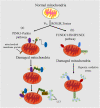The Role of Mitochondrial Dynamics and Mitophagy in Carcinogenesis, Metastasis and Therapy
- PMID: 32587855
- PMCID: PMC7297908
- DOI: 10.3389/fcell.2020.00413
The Role of Mitochondrial Dynamics and Mitophagy in Carcinogenesis, Metastasis and Therapy
Abstract
Mitochondria are key cellular organelles and play vital roles in energy metabolism, apoptosis regulation and cellular homeostasis. Mitochondrial dynamics refers to the varying balance between mitochondrial fission and mitochondrial fusion that plays an important part in maintaining mitochondrial homeostasis and quality. Mitochondrial malfunction is involved in aging, metabolic disease, neurodegenerative disorders, and cancers. Mitophagy, a selective autophagy of mitochondria, can efficiently degrade, remove and recycle the malfunctioning or damaged mitochondria, and is crucial for quality control. In past decades, numerous studies have identified a series of factors that regulate mitophagy and are also involved in carcinogenesis, cancer cell migration and death. Therefore, it has become critically important to analyze signal pathways that regulate mitophagy to identify potential therapeutic targets. Here, we review recent progresses in mitochondrial dynamics, the mechanisms of mitophagy regulation, and the implications for understanding carcinogenesis, metastasis, treatment, and drug resistance.
Keywords: carcinogenesis; mitochondria; mitochondrial dynamics; mitophagy; therapy.
Copyright © 2020 Wang, Liu, Cao, Zhang, Huang and Yi.
Figures


Similar articles
-
Mitophagy, Mitochondrial Dynamics, and Homeostasis in Cardiovascular Aging.Oxid Med Cell Longev. 2019 Nov 4;2019:9825061. doi: 10.1155/2019/9825061. eCollection 2019. Oxid Med Cell Longev. 2019. PMID: 31781358 Free PMC article. Review.
-
[Progress in regulation of mitochondrial dynamics and mitochondrial autophagy].Sheng Li Xue Bao. 2020 Aug 25;72(4):475-487. Sheng Li Xue Bao. 2020. PMID: 32820310 Review. Chinese.
-
Mitochondrial dynamics and mitochondrial quality control.Redox Biol. 2015;4:6-13. doi: 10.1016/j.redox.2014.11.006. Epub 2014 Nov 20. Redox Biol. 2015. PMID: 25479550 Free PMC article. Review.
-
Mitophagy: Link to cancer development and therapy.Biochem Biophys Res Commun. 2017 Jan 15;482(3):432-439. doi: 10.1016/j.bbrc.2016.10.088. Epub 2017 Feb 3. Biochem Biophys Res Commun. 2017. PMID: 28212727 Review.
-
Mitophagy and mitochondrial dynamics in Saccharomyces cerevisiae.Biochim Biophys Acta. 2015 Oct;1853(10 Pt B):2766-74. doi: 10.1016/j.bbamcr.2015.02.024. Epub 2015 Mar 6. Biochim Biophys Acta. 2015. PMID: 25753536 Review.
Cited by
-
Mitophagy Induced by Metal Nanoparticles for Cancer Treatment.Pharmaceutics. 2022 Oct 24;14(11):2275. doi: 10.3390/pharmaceutics14112275. Pharmaceutics. 2022. PMID: 36365094 Free PMC article. Review.
-
Mitochondrial dysfunction significantly contributes to the sensitivity of tumor cells to anoikis and their metastatic potential.Heliyon. 2024 Jun 6;10(12):e32626. doi: 10.1016/j.heliyon.2024.e32626. eCollection 2024 Jun 30. Heliyon. 2024. PMID: 38994085 Free PMC article.
-
Mitochondrion: Main organelle in orchestrating cancer escape from chemotherapy.Cancer Rep (Hoboken). 2024 Feb;7(2):e1942. doi: 10.1002/cnr2.1942. Epub 2023 Dec 27. Cancer Rep (Hoboken). 2024. PMID: 38151790 Free PMC article. Review.
-
Chemotherapy Resistance: Role of Mitochondrial and Autophagic Components.Cancers (Basel). 2022 Mar 12;14(6):1462. doi: 10.3390/cancers14061462. Cancers (Basel). 2022. PMID: 35326612 Free PMC article. Review.
-
Investigation of PRKN Mutations in Levodopa-Induced Dyskinesia in Parkinson's Disease Treatment.Biomedicines. 2023 Aug 9;11(8):2230. doi: 10.3390/biomedicines11082230. Biomedicines. 2023. PMID: 37626726 Free PMC article.
References
-
- Basit F., Van Oppen L. M., Schöckel L., Bossenbroek H. M., Van Emst-De Vries S. E., Hermeling J. C., et al. (2017). Mitochondrial complex I inhibition triggers a mitophagy-dependent ROS increase leading to necroptosis and ferroptosis in melanoma cells. Cell Death Dis. 8:e2716. 10.1038/cddis.2017.133 - DOI - PMC - PubMed
Publication types
LinkOut - more resources
Full Text Sources
Miscellaneous

